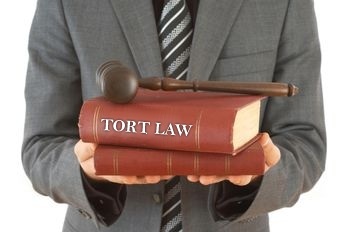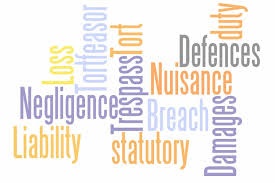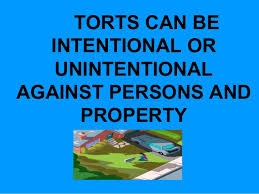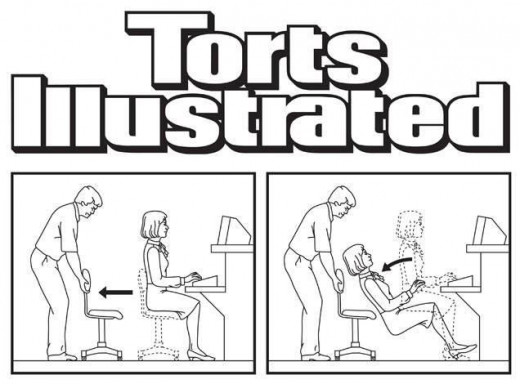The Essence of the Four Torts





A Tort is, a body of rights, obligations, and remedies that is applied by courts in civil proceedings to provide relief for persons who have suffered harm from the wrongful acts of others.
Four types of torts:
- Negligence
- Strict Liability
- Intentional Torts
- Quasi-Intentional Torts
The Essence
The essence of intentional and quasi-intentional torts is consent. The essence of strict liability is the relationship to or ownership of the thing that caused harm, whereas the essence of negligence is a breach of established standards, of care.
The major intentional torts are assault, batter, false imprisonment, intentional infliction of emotional distress, and in specific areas of nursing such as home care, trespass to land. Broadly, defined intentional torts require that there be an intentional interference with an individual’s person, reputation, or property. The degree of intent necessary to commit an intentional tort is broader than having a desire to bring about harm or injury to a person. Intent may also be transferred. For example, you intend to shoot person A, but you miss and shoot person B instead. Even though you have no intent to harm person B, your intent to harm person A is transferred, and the law deems that you have the intent to harm person B. It is a rule of law that “intent follows the bullet." To successfully pursue a lawsuit for an intentional tort, you must prove the defendant had the requisite intent, that the injury resulted from the defendant’s action, and that no defense was present.
Quasi-intentional torts include defamation, invasion of privacy, and breach of confidentiality. Quasi means “resembling,” These types of torts resemble intentional torts but are different because they are based on speech. In defining a defamatory statement, the courts have looked to whether the statement exposed the plaintiff to public hatred, contempt, ridicule, or degradation. There must be proof that there was actual harm to the person’s reputation.
In some cases tort law imposes liability on defendants who are neither negligent nor guilty of intentional wrongdoing. Known as STRICT LIABILITY, or liability without fault, this branch of torts seeks to regulate those activities that are useful and necessary, but that create abnormally dangerous risks to society. These activities include blasting, transporting hazardous materials, storing dangerous substances, and keeping certain wild animals in captivity. Read more: Tort Law - Strict Liability - Activities, Fault, Dangerous, and Society - JRank Articles http://law.jrank.org/pages/10820/Tort-Law-Strict-Liability.html#ixzz3IVAfN3ow
The elements which constitute a negligent tort are the following: a person must owe a duty or service to the victim in question; the individual who owes the duty must violate the promise or obligation; an injury then must arise because of that specific violation; and the injury causes must have been reasonably foreseeable as a result of the person's negligent actions. - See more at: http://tort.laws.com/negligence-standard-of-conduct/negligence-tort#sthash.QplmAw4A.dpuf
Ethical dilemmas can arise for healthcare professional with treating individuals who, for religious reasons, do not allow certain procedures to be performed. If the physicians are aware of the patient’s religious beliefs, then consent is not implied. If the physician is not aware, then the courts will most likely rule that consent is implied, as long as the physician had no way of knowing that religious prohibitions. If the religious prohibitions are known, then consent is not implied even in the case of a minor. The court will only order procedures in the case of a minor. (Novak v. Cobb County). According to (JAMA) in the article Jehovah’s Witnesses – The Surgical/Ethical Challenge, stated “although surgeons have often declined to treat Witnesses because their stand on the use of blood products seemed to “tie the doctor’s hands,’ many physicians have now chosen to view the situation as only one more complication challenging their skill. Since Witnesses do not object to colloid or crystalloid replacement fluids, not electrocautery, hypotensive anesthesia, or hypothermia, these have been employed successfully. Current and future applications of hetastarch, large-dose intravenous iron dextran injection, and the “sonic scalpel” are promising and not religiously objectionable. In 1977, Ott and Cooley reported on 542 cardiovascular operations performed on Witnesses without transfusing blood and concluded that this procedure can be done “with an acceptable low risk.” In response to our request, Cooley recently did a statistical review of 1,026 operations, 22% on minors, and determined “that the risk of surgery in patients of the Jehovah’s Witness group has not been substantially higher than for others.”
Another very important issue in the medical field is protection of a patient’s privacy. The most basic right of patients is to expect healthcare professionals to keep all information obtained in the treatment of the patient confidential. Every state outlines only limited situations in which a person may release information concerning a patient without his consent. Any information that a healthcare provider learns while taking care of a patient is confidential, even if it does not relate directly to the treatment of the patient. The issues of confidentiality are both a legal and an ethical issue. The code of ethics of allied health personnel must emphasize that the healthcare professional must safeguard the patient’s right to privacy by judiciously protecting confidentiality.
It is important for both parties involved in legal cases to understand Tort Law; this knowledge could result in your favor.
Source: Legal and Ethical Issues in Health Occupation-By Tonia Dandry Aiken;Jehovah’s Witnesses The Surgical/Ethical Challenge from The Journal of the American Medical Association (JAMA), November 27, 1981, Volume 246, No.21, pages 2471, 2472 Appendix;Tort Law; http://legal-dictionary.thefreedictionary.com/Tort+Law

![Torts: Cases and Materials [Connected Casebook] (Aspen Casebook Series)](https://m.media-amazon.com/images/I/416rv9GY8hL._SL160_.jpg)






